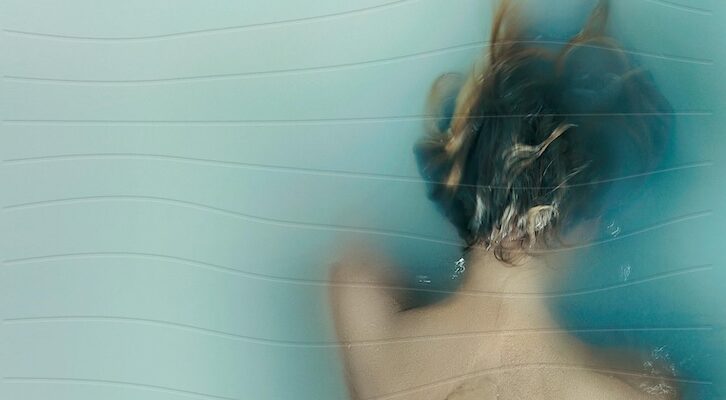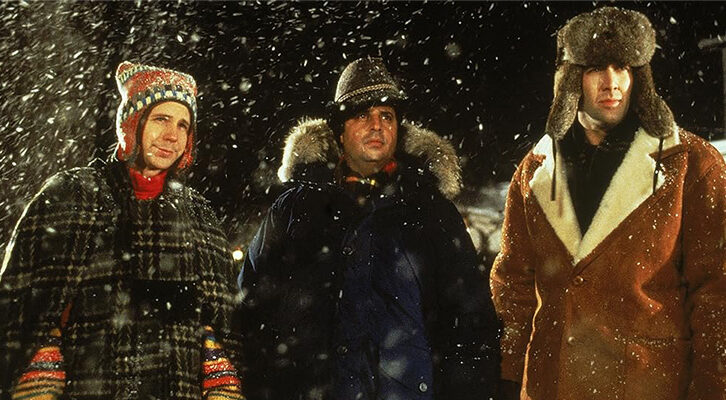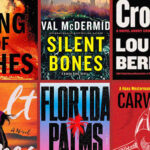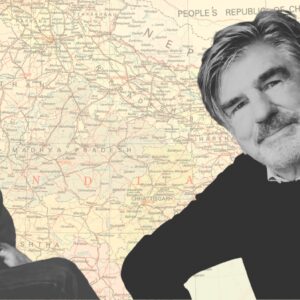
Hot, Moist, Hydrofeminist: Seven Sapphic Books with Themes of Water and Fludity
Siouxzi Connor Recommends Dylin Hardcastle, Julia Armfield, Sophie Mackintosh, and More
When it comes to the Sapphic body in fiction and hydrofeminist texts, there’s one undeniable, recurring quality: it’s wet.
This fluidity of the Sapphic body means it can shift between many physical forms, identities and concepts, but its state always remains watery: moist, misty, flowing, slippery and particularly porous; with the landscapes surrounding it in the texts, and with the other wet bodies sliding and colliding with it narratively.
Physiologically, these states of bodily outpourings are of course quite self-explanatory, given all the melting, leaking, sweating, salivating and squirting the Sapphic body is notorious for in the art of Sapphics of all genders throughout history.
Moving past the obvious physical aspects, the more juicily-ambiguous terrain of the wet more-than-human Sapphic body is what I’ve been most eagerly diving into of late, which is particularly timely given the state of emergency of our oceans and waterways.
The ecological and psychological significance of hydrofeminist texts, (fiction, non-fiction, and autofiction alike), is that they encourage us to go further than just dipping our toes into thinking through the body as fluid, towards radically re-thinking it as being a kind of body of water in itself. Hydrofeminism shifts the tides towards a more embodied form of empathy with water.
I came into this watery way of thinking with bodies and bodies of water through researching and writing my new novel, Your Body of Water (released on June 10 by Repeater Books), which began as a short queer romance in which the teenage version of myself falls into limerence, lust, and eventually love with the river I grew up with in Australia.
While fueled by all the gurgling, rushing passion of a teenager experiencing these feelings for the first time, it’s also a cautionary tale about imposing anthropocentric wants and expectations onto a non-consenting body of water, and all the unrequited emotions and human destructiveness which results.
The narrator grapples with all of this as love hurls her around, completely at sea in her feelings and yet somehow holding onto hope that bravery in love will make it all worth it, in the end:
What’s the worst that could happen if I let myself be carried along, utterly, by you? Yes, I could be smashed upon the rocks of your gorge, and maybe rot away downstream in your wilderness before anyone would ever find me, but wouldn’t that be the ultimate act of love? Is there a word for self-immolation by water? And I don’t mean drowning, I mean allowing my body to be subsumed by the power and rage of a river? My price to pay for so blatantly anthropomorphizing you….
My book flowed into tributaries from there, as the jilted teenager grows up and encounters the intoxicating, ambiguous nether-lands of the swamp that is Berlin; the deep, treacherous waters of post-colonial Lisbon, whose fortunes were first built upon the great Tagus River; interweaving the timeless mythology of the River Styx with a modern-day Sappho rampaging in a Greek bathhouse; and finally acknowledging the eternal scars of the attempted genocide of the First Nations people of Australia, set on the Barwon River in the outback, as a forbidden love story unfolds between the daughter of a wealthy white landowner and their domestic servant, stolen from her own people.
The river setting of this love story is the lifeblood that enables them to forge another life for themselves and completes the circle of the book: a shapeshifting love letter to rivers across time”
With their feet on the warming earth, the river flowing widely by, the two stood and drank each other in: lips, hands, necks, tongues, fingertips, rippling over and through each other. Eliza felt her body becoming alive for the first time, coursing through with a vitality of pure sensation that had been missing for her entire teenage existence.
When she closed her eyes she could see a sky full of shooting stars and when she opened them she could feel the stars exploding in her chest.
The meandering flow of the book’s narrative taught me so much about how painful and damaging it is, for both sides, when we separate our bodies, our needs, our sense of nourishment, and the trajectories of our life stories, from the bodies of water which are so inextricably intertwined with our survival—and theirs with ours. When we ignore the psychogeographies of rivers, seas, lakes, swamps, oceans…all bodies of water…we cut ourselves off from acknowledging the wettest, most vital parts of ourselves.
Hydrofeminist texts (whether specifically Sapphic, or not), hold the potential to swell us through new waves of thinking through the body, queerness, and love, to extend us beyond the boundaries of the physical body. These are ways of thinking which help us to swim with the idea that our human bodies are just as porous and fluid as the more-than-human bodies of water which hydrate our existence.
This is at the heart of why I highly recommend reading the following “wet books”: a selection of works which help reunite us with the juicy hydrofeminist parts of ourselves, and (also just as important!), when you read them on a sticky, sweaty summer’s day, by your chosen body of water, some of these also hold multitudes to get you saturated, in the best possible way.
*

Dylin Hardcastle, A Language of Limbs
This has very quickly become one of my favorite books of all time. Gut-wrenching and honeyed, it is both a tale of queer limerence, and one of the violence love can inflict on us when we try to outrun it.
The sexual charge throughout is electrifying; with glimpses of intimacy and pure bodily pleasure spilled, pooled and flooded over the narrative until it is almost unbearable. The ocean provides some relief—as Hardcastle themself puts it, their characters’ love of the ocean is how they “learn to let the water carry what they can’t.”

Julia Armfield, Our Wives Under the Sea
In Armfield’s debut novel, the ocean is a haunted house which has seeped into the lives of married queer couple Leah and Miri, in irreversible ways. After a six-month deep-sea voyage in which Miri presumed Leah lost, the two must reconfigure who they are to themselves and each other, and face the loneliness of the widening gulf between them.
It’s viscously poetic, and dense with what Miri calls “sunken thoughts,” but the real reward I felt from diving into this book was being forced to remember the sheer bravery it takes to truly love someone, one moment at a time.

Jenny Hval, Paradise Rot
“The house was raw and porous. It didn’t shut out the world outside like houses at home.” Paradise Rot is perhaps less of a wet, watery exploration than the others in this list, and more the study of the porousness of two bodies cohabitating, and the blurring of these bodily lines between each other and their more-than-human cohabitants.
Boundaries collide, dissipate and disintegrate as vivid sexual awakenings and desire take over. It’s hard not to read this book without feeling the through-lines and parallels with Hval’s musical works and performances – somehow the prose sings off the pages with all the searing, endearing honesty of Hval’s stage presence.

Hildegard von Bingen, Huw Lemney, Unknown Language
I found this book by chance at one of my favorite local bookstores in Berlin, Zabriskie Books. It jumped out to me as it bore the startling claim of being “co-written” by twelth-century mystic, abbess, scientist, composer, herbalist and inventor of one of the earliest known constructed languages by a woman, Hildegard von Bingen.
I devoured the strange, erratic, often confusing narrative in one or two sittings, and it only helped to fuel my Hildegard obsession. Traversing through both queer and divine love, in a post-cataclysmic 2020 world, the watery notions in this book are more along the lines of the fluidity of identity, time and language, (although sea caves and rivers do rate an honorable mention).

Sophie Mackintosh, The Water Cure
Another dystopian setting, but one which feels all the more eerily believable in these times we’re living through now. After their patriarch disappears from their isolated island, a mother and her three daughters are forced to completely reconfigure their world view and question everything they have been subjected to, including traumatizing “water cures.”
“My feelings are limping, wretched things,” laments Lia, one of the daughters. “Underwater, staring at the stained tiles, I scream as loudly as I can. The water kills the sound.” If you’re in the mood for some feminist revenge with a lush ocean setting, this might be for you.

Maggie Nelson, Bluets
This has been a long favorite, and one I return to in moments of my own “blue,” as the prose poetry fragments offer changed insights each time I dip my toes in. Like the notion of never stepping into the same river twice, the protagonist in my own book, upon finally accepting that loving a river is an act of loving an ever-changing, never-graspable flow, is irrevocably changed by that painful experience and yet doesn’t have the staying power to grieve it.
On the contrary, Bluets is set on the tidal shores between love and grief and stays there, boldly, even with the threat of the self being swept away entirely. I read in one review of Bluets that the whole thing was originally written in blue ink which is apparently a reminder, like how Keats reminded us, that all words are written in water.

Andrea Lawlor, Paul Takes the Form of a Mortal Girl
Those last few recommendations delved into the bluer, heavier side of love and desire, but this last one is nothing short of a riotous queer romp. Set in the early 90s, and bouncing around between Iowa and San Francisco, the protagonist, Paul/ Polly, is unlike any other you’ll likely encounter.
As Paul/ Polly hurtles through queer love and lots of sex across America, they are able to shift genders at will, and even modify their genitalia and body shape as they see fit—for either their own pleasure or the pleasure of their partner(s). For those too young to have lived through the 90s, or for those who are hungry with nostalgia, this fun, sexy exploration of fluidity is one to pack for all your watery summer adventures.
*
Further Hydro/Ecofeminist Reading:

Astrida Neimanis, Bodies of Water

Luce Irigay, Michael Marder, Through Vegetal Being

Rebecca Tamas, Strangers: Essays on the Human & Nonhuman
______________________________

Your Body of Water by Siouxzi Connor is available via Repeater Books.
Siouxzi Connor
Siouxzi Connor is an Australian-born writer and experimental filmmaker. Her work includes moving-image and installation art, photography, and performance, exploring ecology, sexuality, and hydrofeminisms. Her first book, Little Houses, Big Forests (desire is no light thing), was published by Repeater Books in 2017. She is also the author of Your Body of Water. She is a former research fellow of the ICI and co-founder of feminist organization, WØMB. She is based in Berlin.



















